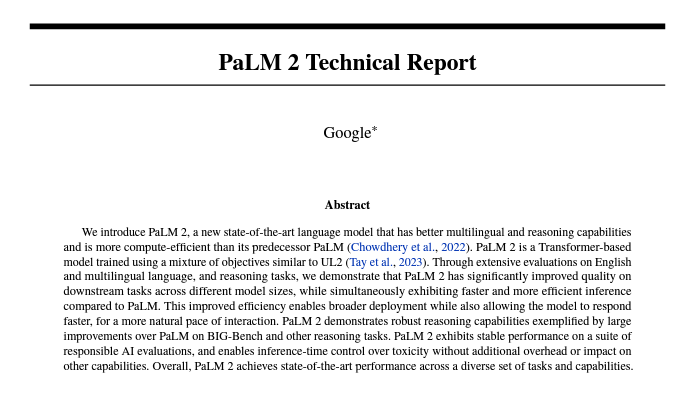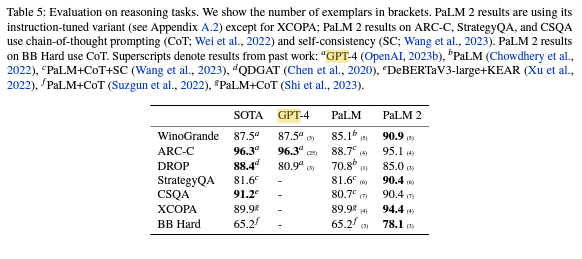Ever since the release of GPT-3, the world has been abuzz with the possibilities of what the next generation of AI could bring.
Enter PaLM 2 (New Bard), Google’s answer to OpenAI’s cutting-edge model.
This article will provide you a detailed breakdown of PaLM 2, its applications, and how it compares to its competitor, GPT-4.

A New AI Contender: PaLM 2
PaLM 2 is Google’s latest large language model, which has been making headlines in the Artificial Intelligence community. Developed by Google DeepMind, this groundbreaking model has been fine-tuned to offer a wide range of applications, including translation, coding, and even medical question-answering.
But what sets PaLM 2 apart from its predecessor, GPT-3, and its rival, GPT-4? Let’s dive into the unique aspects of this AI model that make it a game-changer in the world of artificial intelligence.
Multilingual Capabilities
One of PaLM 2’s most notable improvements is its impressive multilingual capabilities. With support for a vast array of languages, this model demonstrates remarkable linguistic prowess, making it a valuable tool for businesses and individuals operating in a global market.
Take, for example, the translation of a Tajiki paragraph into Persian. PaLM 2 can not only translate the text accurately but also maintain the context and nuances of the original content. This level of language understanding goes beyond simple word-for-word translation, making it an invaluable asset for companies looking to communicate effectively across language barriers.
Improved Code Generation
PaLM 2 has also shown noteworthy improvements in code generation compared to its predecessors. While GPT-4 has a pass-at-one accuracy rate of 82%, PaLM 2S, the specialized coding model, achieves a respectable 37.6%. Although it doesn’t quite surpass GPT-4, the progress in code generation is commendable and highlights the potential for future growth in this area.
What’s particularly interesting about PaLM 2’s code generation is the inclusion of code citations. Developers have praised this feature, which links to the original source of the code when a block of code is generated. This added level of transparency ensures that code attribution is maintained, giving credit where credit is due.
Medical Applications: Med PaLM 2
The medical field is another area where PaLM 2 is making significant strides. Med PaLM 2, a specialized version of the model, is designed explicitly for the medical domain. With an impressive score of 85 on the USMLE medical licensing exam, Med PaLM 2 has an unlimited potential on different industries, especially the healthcare by providing a reliable medical question-answering services.
If you want to see an in depth video and evaluation of the technical report:
https://www.youtube.com/watch?v=u_dSUtp4eM8
This amazing piece of content was created by AI Explained, follow their channel for more videos. The video above is from “AI Explained” and all rights belong to their respective owners.
Imagine a world where doctors and medical professionals can access AI-powered tools to help diagnose patients and make informed decisions about treatment options. Med PaLM 2 is a step towards realizing that vision, and its success in answering USMLE questions is a testament to its potential impact on healthcare.
PaLM 2 vs. GPT-4: Who Comes Out on Top?
While PaLM 2 has many impressive features, the million-dollar question is whether it can outshine its rival, GPT-4. The answer isn’t black and white, as both models have their strengths and weaknesses.
In terms of multilingual capabilities, PaLM 2 seems to have an edge over GPT-4. With its advanced language understanding and translation abilities, it offers a more comprehensive solution for businesses and individuals looking to bridge language gaps.

However, when it comes to code generation, GPT-4 still maintains its lead, with a higher pass-at-one accuracy rate. That being said, PaLM 2’s code citation feature sets it apart, offering a unique advantage in terms of code transparency and attribution.
In the medical domain, PaLM 2 has demonstrated significant progress with Med PaLM 2, which could potentially revolutionize healthcare. While GPT-4 does offer some medical applications, the dedicated Med PaLM 2 model appears to be more fine-tuned for this specific purpose.
Overall, it’s difficult to crown a definitive winner in the battle between PaLM 2 and GPT-4, as both models excel in different areas. However, what’s clear is that these advancements in AI are pushing the boundaries of what’s possible and opening up new opportunities across various industries.
What’s Next for PaLM 2?
With the impressive progress made by PaLM 2, one can’t help but wonder what the future holds for this AI model and the world of artificial intelligence in general.
Continued Scaling and Improvement
Google DeepMind is committed to further scaling both the model parameters and dataset size and quality, as well as improving the architecture and objectives of PaLM 2. This continued development is expected to yield even greater gains in language understanding and generation.

As AI models like PaLM 2 and GPT-4 grow in capability, the potential applications across various sectors will only increase, leading to a more interconnected and technologically advanced world.
Collaboration and Ethical Considerations
As Artificial Intelligence continues to advance at this pace, collaboration between leading tech companies like Google and OpenAI becomes more critical. By working together, they can pool resources and expertise to address the challenges and risks associated with AI, such as safety, ethical concerns, and potential misuse.
The recent meeting between the CEOs of Google, Microsoft, and OpenAI, along with the CEO of Anthropic, at the White House to discuss AI risk and opportunity is a positive step towards fostering collaboration and addressing these concerns.
In Conclusion
PaLM 2 (New Bard) is a testament to the incredible progress being made in artificial intelligence. With its impressive multilingual capabilities, advanced code generation features, and the potential to revolutionize healthcare through Med PaLM 2, this AI model is certainly making waves in the industry.
As the race between PaLM 2 and GPT-4 continues, it’s essential to remember that AI’s potential impact on society reaches far beyond competition. By focusing on collaboration and addressing the challenges and risks associated with AI, we can ensure a future where technology serves humanity in a safe, ethical, and responsible manner.
We hope this comprehensive breakdown of PaLM 2 has given you a better understanding of this groundbreaking Artificial Intelligence model and its potential applications.
Note: The views and opinions expressed by the author, or any people mentioned in this article, are for fictional and entertainment purposes only, and they do not constitute financial, investment, or other advice.
Relevant Articles:
GPT-4 Seems Smarter than we think: What is SmartGPT?
Google AI Documents Leak: Insights into the AI Arms Race
AI News: Unveiling the Fascinating Word of Artificial Intelligence

